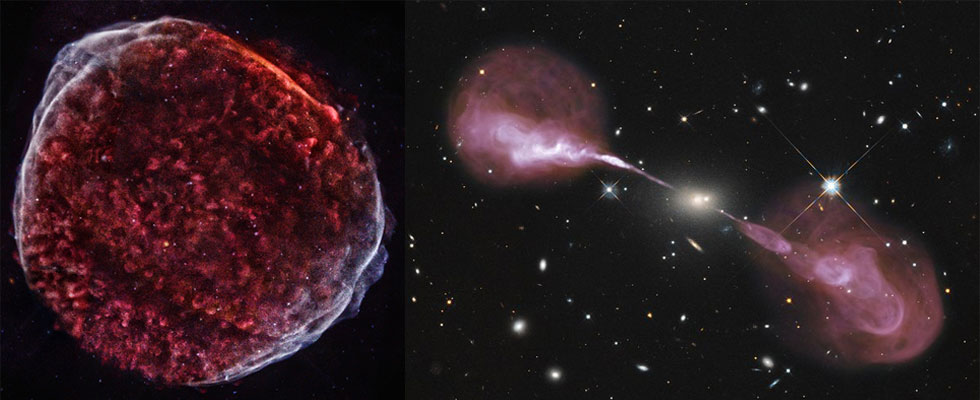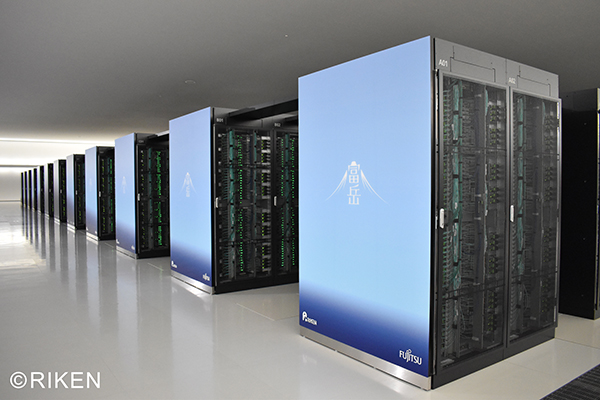Project Associate Professor
Division of Plasma Astrophysics

Cosmic rays are high-energy charged particles that can be found traveling throughout the universe. Cosmic rays have energies from 109 eV to 1020 eV (1 eV =1.6 x 10-19 joules). Meanwhile, the energy of plasma, made up of charged particles (ions and electrons), is on the order of a few electronvolts. Understanding how charged particles in cool plasmas can transform into high-energy cosmic rays with energies more than 10 orders of magnitude greater remains an enormous challenge.
Observations of high-energy neutrinos and telescope-based observations of electromagnetic waves (X-rays, gamma-rays, etc.) have suggested that cosmic rays are generated by relativistic jets erupting from black holes, and by supernovas and other phenomena that release tremendous amounts of energy. (See Figure 1.) In supernova remnants, we can clearly see X-rays being emitted by high-energy electrons near the shock wave front of the stellar explosion. In active galaxies, it is thought that jets of matter ejected from the core in both directions form a strong shock wave when they interact with surrounding plasma and generate high-energy cosmic rays by accelerating charged particles near the shock wave. Jets from an active galactic nucleus and the high-energy particles accelerated in the vicinity are a strong candidate for the source of the high-energy neutrino captured by the IceCube Neutrino Observatory at the South Pole in September 2017, but the mechanism by which charged particles are efficiently accelerated at the shock wave is not yet clear.
In our research, we are attempting to apply our knowledge of plasma physics to astronomical phenomena and uncover what that mechanism is. In order to clarify what is accelerating the particles, we need to return to the distribution function of position and velocity for the plasma-particle system, and are forced to consider the system using fundamental plasma physics equations, namely the collisionless Boltzmann equation (and Maxwell’s equations). We are working on methods of numerical simulation to solve these strongly non-linear equations. However, a plasma-particle simulation represents a many-body charged particle system and that means that there is a colossal number of calculations to be done; for that sort of simulation, the power of a supercomputer is required. We developed a simulation code that allows us to solve the collisionless Boltzmann equation very quickly, and successfully adapted it to handle parallel computing using hundreds of thousands to millions of processors, such as those found in the "K" supercomputer and its successor "Fugaku".
We were able to make full use of the computing horsepower of the K supercomputer to conduct a super-large-scale simulation in six dimensions: three for position and three for velocity. That simulation showed that turbulence in the strong magnetic field dominant at the shock front scatters electrons, which can trap particles in the acceleration region near the shock front for long periods of time. This showed that it is possible to continuously accelerate particles to high energies.
Turbulent fluctuations near the shock wave. (From Matsumoto et al. Phys. Rev. Lett., 2017)
Large-scale simulations are an important research tool as they lead us to new physical mechanisms, and reveal ideas that we could never have imagined before. While we previously used the super computer K for this work (now decommissioned), we are now able to utilise K's more powerful successor, Fugaku. By harnessing Fugaku, we will be able to simultaneously handle proton (ion) acceleration, something we could never consider before now. If we can gain a better understanding of both electron and proton acceleration, we believe we will take another step forward towards grasping the origin of high-energy neutrinos. Through that, we can also look more carefully at the mechanisms generating the extremely high energy neutrinos observed by the IceCube Neutrino Observatory. We are now witnessing an emerging synergy between the neutrino observation and theoretical simulation teams conducting research at ICEHAP.
In addition, large-scale simulations require us to analyze hundreds of terabytes (100 TB = 1014 bytes) of data. Now with Fugaku, we will need to handle more than petabytes (1 PB =1015 bytes) of data, so we believe a breakthrough in data analysis technology is needed. We have begun researching the use of machine learning technologies for use in discovering accelerated particles, with the goal of integrating high performance computing (HPC) systems with AI in the future.
